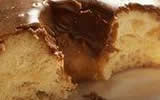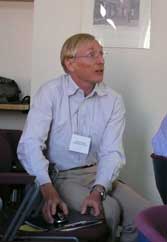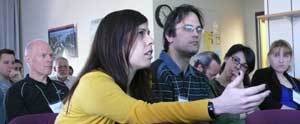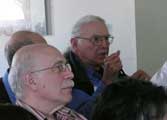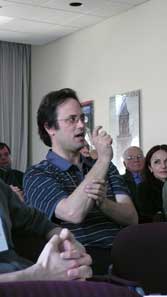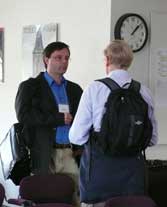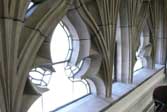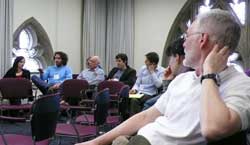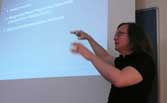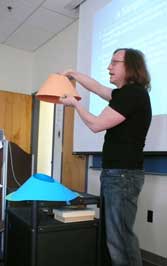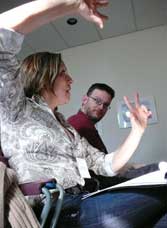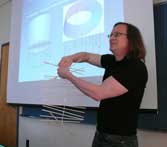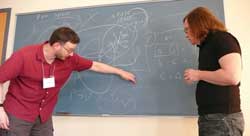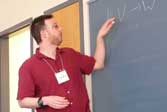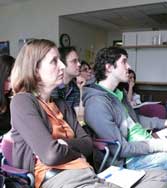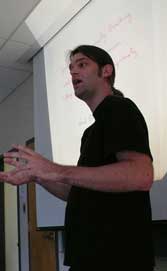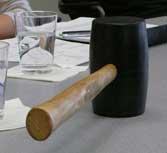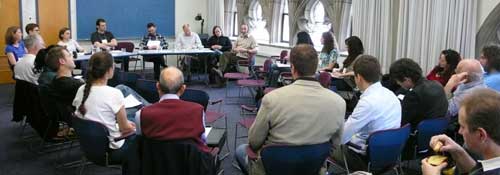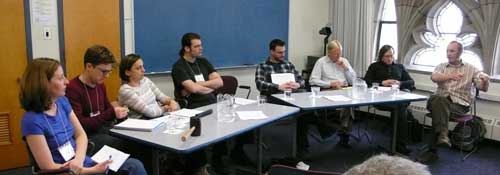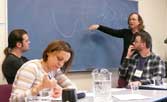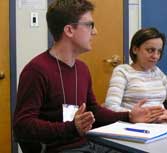::: center home >> being here >> last donut? >> gauge |
18-19 April 2009 What is gauge theory? Or, more completely, what is the theory of gauge fields? It is an arcane but exploding branch of particle physics that deals with certain types of interactions in the particle physics of the standard model. What does philosophy have to do with it? Gauge theory has become part of the long tradition of advances in modern physics that offer philosophers perplexing puzzles. Its literature is flourishing and rich in unresolved disputes. That makes it an ideal topic for a workshop. There we can assemble people who need to talk face to face and at length. That was the plan over a year ago, when Richard Healey, John Earman and I began to sketch out the who and what of a workshop. I was especially pleased that Richard was helping us organize. His researches are at the forefront of modern philosophical writing in gauge theory. Indeed just a few months before Richard's book Gauging What's Real: The Conceptual Foundations of Contemporary Gauge Theory won the coveted Lakatos Prize in philosophy of science. Since it is a part of modern quantum physics, gauge theory is already immersed in many quantum conundra: failure of determinism; cats that are both live and dead; and particles that have fled long ago to Alpha Centauri but somehow remain entangled with a counterpart particle left here on earth. However gauge presents new puzzles peculiar to the theory itself.
That is immediately perplexing. How can the magnetic field HERE affect things over THERE, where the magnetic field is not. At first, any comprehension seems impossible. But then there is a clue. While there is no magnetic field outside the coil, there is a potential field, "A", the vector potential--a gauge field. It is normally discounted as having no real existence in its own right. The reason for this skepticism is that there are infinitely many different A fields for any one magnetic field. That means that any physical reality there can be represented by many different fields, each transformable into another. These transformations are known as "gauge transformations." They change nothing of physical significance. So no one of these very many A fields, read literally, can give us the true physical state of something. In this regard, the gauge field is not so different from a number you might come up with when you halt half way through adding a huge column of figures. Since you can halt at any point of your choosing, the number can have all sorts of values. It really only has a meaning as an intermediate on the way to the final sum. So it is, on the standard story, with gauge fields. They are useful as an intermediate on the way to computing the real fields, in this case, the magnetic field that deflects compass needles. Then comes Aharonov and Bohm's effect. Charged quantum particles do feel something when there is no magnetic field, but there is a gauge field. So there has to be something physical in the gauge field in its own right. But what? We cannot give the straight answer, "the A field," on pain of being unable to say which A field. Electromagetic theory admits infinitely many A fields, all perfectly fitted to the one coil and everything that can be observed in association with it. What is real has to be something less. It has to be something that is common to all these fields. But what? Here we connect with the most ancient project of philosophy: ontology, the theory of what is. Reflections on gauge fields are about to give us a surprizing answer to the fundamental question "what is there?" at least in the case of gauge fields. Richard's answer depends upon considering the closed loops that anyone can trace out in space around the coil. Imagine a loop of string that encircles the solenoid. Now imagine all possible loops like that; and even those that don't encircle the solenoid. Some are small and almost hug the solenoid exactly. Some are large and never get close to it. All these loops define pathways in space. Now pick any A field at all compatible with the coil. Along each pathway, we can add up the cumulative effect of this A field. The collection of all of these sums on loops are called the holonomies of the field. These holonomies, Richard has told us in his book and now tells us again in person, are what is real. That declaration is possible because of the dominating fact in the discussion. While infinitely many A field are possible for the one coil, they all reduce down the same set of holonomies. And it is just this one set that is needed to predict everything observable. Here we have another oddity brought to light by quantum theory. We thought that the real of the fields of electromagnetism resides in field quantities at points. It turns out that we have to replace the "at points" with "at loops." The fields do not attach to points but to loops spread out in space. All this unfolds in an unusual way. Richard has chosen a mode of presentation I've never seen before. Usually speakers stand in front of us and twist their gaze back and forth from us to the projector screen behind. Instead Richard chose to twist less and sit in the second row from where he controlled the change of digital screens with a wireless mouse. Some people--me, for example--find Richard's holonomy ontology striking, at first. But we have had to learn to like a lot of odd things. So why not this one? Others, however, find this new holonomy ontology just too disagreeable to be accepted without a fight. One of these in Antigone Nounou, who is sitting just behind me. As Richard develops his case, she is shuffling a little more and a little more again in her seat; and then begins to utter barely audible responses. Richard is quite familiar with her worries and with those posed by others. He shifts into the second half of his talk and begins an inventory why this holonomy ontology might be regarded as defective. He believes he can parry all threats but one. How, an imaginary challenger asks, do the holonomies interact causally with the quantum fields? The holonomies exist distributed in loops in space. But who can say where a quantum particle is in space? Then Richard parries. That is just the familiar quantum weirdness. We can never give nice causal accounts of what these quantum particles are up to. There's no special problem with gauge fields. And why should we demand a nice causal story anyway? Richard then reminds us of Bertrand Russell's famous old retort that causality is simply unnecessary for science. (This last thought is actually quite common among philosophers of physics, just as it is shocking for metaphysicians!) Question time was approaching and we had an audience steeped in thoughts of gauge and ontology. It was clear at this early stage that we were heading for one of the most vigorous and interesting workshops at the Center. This was a welcome realization. For this workshop had been more heavily subscribed than most. Our workshops are almost invariably open events and we encourage everyone to come to them. However we do appreciate an email letting us know you are coming so we can keep everyone well supplied with the necessities of workshop life: a chair, a nametag, coffee, bagels and buns, and so on. In the months and weeks prior to the workshop, a slow but steady stream of these emails arrived and our list of attendees grew.
James Mattingly gave the next talk. He came back to Richard's holonomies and pronounced provocatively "bad ontology." We could, he urged, get away with something conceptually much simpler if we just allowed each little moving charge in the coils to generate its own magnetic effect outside the coil. We can then recover the total magnetic effects outside the coil merely as the sum of the effects of each of these component magnetic effects. The standard idea is that there is no magnetic field outside the coil. It arises merely because we add up all the component fields generated by each charge in the coil and get a zero. The whole problem arises, James insisted, because we aggregate these component fields before we seek their effects. James solution was bold and simple: don't aggregate first. The idea was so ingenious and presented with such persuasive clarity that I was quite willing to forgive him for its utter wrong- headedness. It was, I mused inwardly, to bring electrodynamics back to something like the state it had in the mid 19th century when electrodynamic processes were conceived as the pairwise interactions of charges. I forgave him for his courageous heterodoxy, but not to the extend that I would forgo pursuing him doggedly in question time. How, I asked him then, are we to see this as a simplification? It replaces one field at a point in space by many, and, if the source charges are continuously distributed, there will have to be infinitely many such fields, somehow generated by the infinitely many smallest elements of the distribution (whatever they may be). We broke for lunch. Our tradition is to set everyone loose to find their own lunch at the many eateries on Forbes Ave. and Craig St. Our meeting room is open and bright. It has light filled, gothic windows with glorious views over Oakland. But even the grandest palace becomes a prison if one cannot leave.
That, Tim urged, is the situation with these gauge fields; and the mathematics is really not that complicated. Everyone can grasp it if they can visualize a few simple things like bundles of sticks tied together or cones of cardboard. To drive his point home, Tim had brought just these items as props and began to illustrate the fiber bundle perspective in simple, even homely terms. It was all gloriously entertaining. Richard had spoken with the clear authority of the defining thinker of the field. James was the paradoxer. He had found the crazy idea that might just might be right. He was daring us to prove him wrong and then fluently answering every objection. Now here was Tim. An innocent observer might think he was showing off one of his children's latest school projects. For us following Tim's words, it was quite different. Tim had seen a profound simplicity behind complicated appearances and he was determined to communicate that vision to us, no matter what it took. There was more to come. Gordon Belot was going to comment on Tim's story and Ward Struyve would shortly tell us how to think about all the suggestive but baffling talk of the spontaneous breaking of gauge symmetry in particle physics. We had a dinner planned for everyone in the room. It would be in a small, cosy library at the venerable Pittsburgh Athletic Association across the street. Then, the following morning, there would be a free-for-all round table discussion. Katherine Brading from Notre Dame had agreed to chair. I thought it might be useful if she took the large, rubber-headed mallet we keep here for such occasions. John D. Norton Saturday-Sunday, 18-19 April 2009 |

